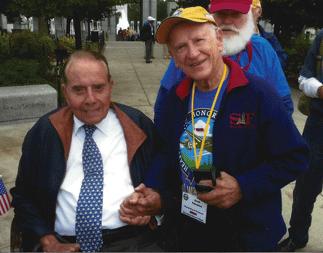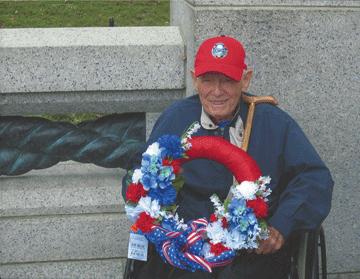
Korean War vet Erwin Stern had never been to Washington, D.C., until he was chosen to participate in the Heartland Honor Flight. He said it was a great honor, as did two other Jewish men and World War II veterans — Jack Forman and Erwin LaPine.
“It was absolutely fantastic to see all those memorials,” Stern said.
“It was a great thrill to be able to go,” Forman added.
The Honor Flight took the three men to the nation’s capital on Oct. 7, and it was a day they will never forget. The Honor Flight Network is a non-profit organization created solely to honor America’s veterans for all their sacrifices to this country. It transports “our heroes” to Washington, D.C., to visit and reflect at their memorials. Top priority is given to senior veterans, World War II survivors and other veterans who may be terminally ill.
The organization’s goal is to help every single veteran in America who is willing and able of getting on a plane or a bus to visit their memorial. Among the sites these veterans visit during the one-day visit that begins before dawn and ends around midnight are Arlington Cemetery, World War II Memorial, Korean War Memorial, Vietnam Veterans Memorial and the Marine Corps War Memorial.
All three applied for the flight for the first time this year. A member of the Korean War Veterans Association Chapter #181, Stern learned about it from the association. Forman said the senior living community where he lives provided the information to vets who are residents and LaPine learned about it through Jewish War Veterans Post 605, of which he is a member.
This trip consisted of 95 vets and 95 guardians. Each vet is paired with a guardian, who stays with the vet the entire day taking care of any and all needs the vet may have. The trip is free for the vets, but the guardians, who may also be vets, must pay their own way. Doctors and other medical personnel are part of the travel group as well.

The country’s senior vets are dying out quickly. Sixteen million served our nation in World War II and it is estimated that only 1.7 million are still alive. During the Korean War, 5.7 million served the United States; 2.275 million are estimated to be living today.
All three men pointed out the guardians work hard all day, as many of the participants are in wheelchairs or use walkers to assist them in getting around. They traveled through Washington on three buses, which were accompanied around town by police escorts as a show of respect to their importance and making it possible to complete their itinerary in one day.
The first stop was at the World War II Memorial, the newest of the memorials that opened in 2004. Former Kansas Sen. Bob Dole met them there.
“The World War II Memorial is beautiful,” Stern said.
Stern was most impressed with the Korean War Memorial.
“I thought it was very unusual. There are statues with soldiers wearing ponchos in the field,” Stern said, noting he doesn’t remember ever even having a poncho when he was in Korea. “I got wet.”
Stern, a native of Austria, was drafted into the Army in January 1951. He went to Korea in May that year and returned to the States in August of 1952. He was a MP in Korea, serving in Kumwa and Chun Cong.
There’s a lot of grass at the Korean Memorial, but Stern said there wasn’t that much grass during the war in Korea.
“There was mostly mountains and dirt roads,” he said.
The best part of his tour, Stern said, was the two weeks he got to spend in Tokyo after he spent six months at the front.
Just two weeks before he was to return home, his gun jammed and went off, wounding him in the hand. Instead of coming home he was airlifted to Kobe, Japan, where he spent three months in the hospital.
All three men were impressed by the changing of the guards and the ceremony where a wreath was placed at the Tomb of the Unknown Soldier.
“The most touching part of the day was the changing of the guard at Arlington Cemetery,” said LaPine.
Stern noted how impressive and precise the movements of the guards are.
LaPine, who had been to Washington several times before, having taken some of his grandchildren there to “get them enthused about American history,” said he was a little self-conscious to be on the trip.
“I felt embarrassed going, seeing people who really saw combat,” said LaPine, who was stationed far from the action in World War II. When he was 19 he joined the Army Air Force and was assigned to Jamaica for a year where he served as a petroleum storage technician for a little more than two years.
“But for every man that was fighting there were five or six people behind them as part of the supply train,” LaPine said.

The vets were treated like heroes on every leg of the trip, beginning with patriotic music on the flight out to Washington, to the crowd of well-wishers that greeted them when they landed in Washington and returned to Kansas City.
“We got a tremendous reception everywhere we went,” said Forman, who went overseas in January 1945. He was assigned to the 51st Armored Infantry Battalion, part of Patton’s 4th Armored Division, after the Battle of the Bulge. He served during combat in Luxemburg, Germany and Czechoslovakia until the war ended in May 1945. After the war was over he continued to serve as part of the Occupation Forces in Europe. Overall he was in the service for 34 months, returning to the United States for discharge in June of 1946 when he was 21 years old. He was awarded the Bronze Star for combat infantry service.
“People really showed their appreciation to us when we got to Washington and then we got back to our own airport at 10:30 at night there was about 1,000 people down there. Many were school children even though there was school the next day wanting to shake our hands and thank us for our service,” Forman explained.
“I went to the airport when Erwin got back,” said his wife, Betty Stern. “They gave us all American flags to wave.”
Each vet was also greeted with mail call, receiving a packet with letters from kids and adults thanking them for their service. Betty Stern was also impressed that Honor Flight officials also contacted each of the veterans’ families, and the vets’ mail often included letters from family members as well.